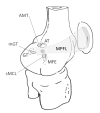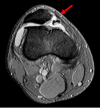MPFL reconstruction: indications and results
- PMID: 32555079
- PMCID: PMC7944812
- DOI: 10.23750/abm.v91i4-S.9669
MPFL reconstruction: indications and results
Abstract
Background and aim: The medial patellofemoral ligament (MPFL) is the most important structure commonly injured during lateral patellar dislocation and its rupture accounts for 3% of total knee injuries. MPFL reconstruction (MPFLR) is a reliable procedure with good results but variable rates of recurrent instability. The aim of this study is to underline the proper indications for the MPFLR reconstruction and to explain all the pearls and pitfalls regarding the MPFLR both in our experience and found in the latest literature.
Methods: A comprehensive search in the latest literature using various combinations of the keywords MPFL, MPFLR, dislocation, treatment was performed. The following data were extracted: diagnosis methods, indications and contraindications for isolated MPFLR, type of management, recurrence of instability, outcomes and complications.
Results: History of multiple patellar dislocations is the most relevant indication for ligament reconstruction especially after a failed course of conservative treatment in presence of persistent patello-femoral instability. Gold standard technique for MPFLR has not been clearly defined yet.
Conclusions: There is still poor literature about outcome comparisons, therefore it is challenging to decide which technique is the most appropriate as surgical procedures are continuously developing. The ideal candidates for MPFLR have to be decided after a throughout evaluation and careful planning and, with nowadays knowledge, it is possible to put indication for a reconstruction exposing the patient to minimal risks.
Conflict of interest statement
Each author declares that he or she has no commercial associations (e.g. consultancies, stock ownership, equity interest, patent/licensing arrangement etc.) that might pose a conflict of interest in connection with the submitted article
Figures




Similar articles
-
Isolated versus combined medial patellofemoral ligament reconstruction for lateral instability of the patella.J Orthop Surg (Hong Kong). 2019 Jan-Apr;27(1):2309499018820698. doi: 10.1177/2309499018820698. J Orthop Surg (Hong Kong). 2019. PMID: 30798706
-
The remaining parameters of patellar instability could be affected for osteoarthritic change after medial patellofemoral ligament reconstruction with or without anteromedialization of the tibial tubercle osteotomy for patellar instability: a retrospective cohort study.BMC Musculoskelet Disord. 2023 Jan 23;24(1):56. doi: 10.1186/s12891-022-06100-3. BMC Musculoskelet Disord. 2023. PMID: 36683021 Free PMC article.
-
Femoral tunnel enlargement after medial patellofemoral ligament reconstruction: prevalence, risk factors, and clinical effect.Am J Sports Med. 2014 Feb;42(2):297-301. doi: 10.1177/0363546513512771. Epub 2013 Dec 6. Am J Sports Med. 2014. PMID: 24318612
-
Indications for Medial Patellofemoral Ligament Reconstruction: A Systematic Review.J Knee Surg. 2016 Oct;29(7):543-554. doi: 10.1055/s-0035-1564730. Epub 2015 Oct 29. J Knee Surg. 2016. PMID: 26516072
-
Isolated medial patellofemoral ligament reconstruction for recurrent patellofemoral instability: analysis of outcomes and risk factors.J Orthop Surg Res. 2021 Apr 6;16(1):239. doi: 10.1186/s13018-021-02383-9. J Orthop Surg Res. 2021. PMID: 33823887 Free PMC article. Review.
Cited by
-
Anatomical Double-Bundle Medial Patellofemoral Ligament Reconstruction With Autologous Semitendinosus, a Single Patellar Tunnel Technique.Arthrosc Tech. 2021 Dec 1;10(12):e2819-e2825. doi: 10.1016/j.eats.2021.08.028. eCollection 2021 Dec. Arthrosc Tech. 2021. PMID: 35004166 Free PMC article.
-
Older Age, Female Sex, Anxiety, Substance Use Disorder, Osteoarthritis, Tibial Tubercle Osteotomy, and Opioid Familiarity Are Risk Factors for Prolonged Opioid Use Following Medial Patellofemoral Ligament Reconstruction.Arthrosc Sports Med Rehabil. 2023 Apr 22;5(3):e637-e647. doi: 10.1016/j.asmr.2023.03.003. eCollection 2023 Jun. Arthrosc Sports Med Rehabil. 2023. PMID: 37388870 Free PMC article.
-
Evaluation of Patella Anatomy for Total Knee Arthroplasty Approaches.Cureus. 2024 May 7;16(5):e59852. doi: 10.7759/cureus.59852. eCollection 2024 May. Cureus. 2024. PMID: 38854214 Free PMC article.
-
Clinical and radiological outcomes following isolated double-bundle medial patellofemoral ligament reconstruction for patellar instability in mature and normal lower limb alignment patients: a 12-year follow-up case series.J Orthop Surg Res. 2025 May 10;20(1):452. doi: 10.1186/s13018-025-05869-y. J Orthop Surg Res. 2025. PMID: 40349065 Free PMC article.
-
After MPFL reconstruction, femoral tunnel widening and migration increase with poor tunnel positioning and are related to poor clinical outcomes.Knee Surg Sports Traumatol Arthrosc. 2023 Jun;31(6):2315-2322. doi: 10.1007/s00167-022-07277-9. Epub 2022 Dec 24. Knee Surg Sports Traumatol Arthrosc. 2023. PMID: 36564507
References
-
- Sillanpaa PJ. First-time patellar dislocation: surgery or conservative treatment. Sport Med Arthrosc. 2012;20(3):128–135. - PubMed
-
- Duthon VB. Acute traumatic patellar dislocation. Orthop Traumatol Surg Res. 2015 Feb;101 - PubMed
-
- LaPrade MD, Kallenbach SL, Aman ZS, et al. Biomechanical evaluation of the medial stabilizers of the patella. Am J Sports Med. 2018;46:1575–1582. - PubMed
Publication types
MeSH terms
LinkOut - more resources
Full Text Sources

